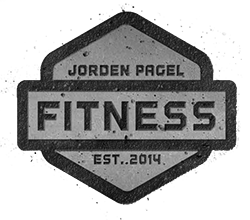Setting A Caloric Deficit For Fat Loss
It’s no secret that I am a big proponent of counting calories and/or macros. I’ve only written about the benefits of it here, here, here, here, and here.
The only way to lose weight is to create an energy deficit by consuming fewer calories than you burn. And while I will admit that counting is not right for everyone in every situation, I truly believe it is the most effective and efficient way to lose fat.
And until someone can prove me wrong, I am sticking with that conviction.
But not many people know how to create the right deficit, or even find out how many calories they should be eating.
I believe this is valuable information for everyone, so today’s article is going to focus on not only figuring out how many calories you need each day, but how to set a deficit based on your goals and situation.
You Get Out What You Put In
Before we get into it, I feel it is important to address something first.
Like anything in life, you get out of fitness what you put into it. The biggest argument against counting calories is that it’s hard. And while ‘hard’ isn’t exactly the word I would use, it does take a little time and work for most.
But think about it this way…what new skill do you not have to work at a bit to develop? Sure, there are some things that come naturally to some people. But to get good at or comfortable with something, you need to put in the time and effort needed to get good at it. And once you do get good at it, it becomes second nature to you, and you don’t even have to think, you just do it.
So if losing weight and getting in shape are truly important to you, why would you not put in the work necessary to achieve your goals?
Finding Maintenance Calories
In order to set a deficit for fat loss, you first need to figure out how many calories you need on a daily basis. This is known as your caloric maintenance, or the number of calories you would need to eat to maintain your bodyweight.
Your maintenance calories are made up of five factors: your basal metabolic rate, your activity levels, the thermic effect of food, your non-exercise activity, and metabolic adaptation.
Let’s talk about each one individually…
- Basal Metabolic Rate (BMR)
Your BMR is the number of calories you burn at rest on an empty stomach. Basically if you woke up in the morning, stayed in bed, and didn’t move for the rest of the day, your BMR would make up all the calories you burn.
A persons BMR is largely affected by their lean body mass and total body mass, meaning that the more mass you have, the higher your BMR.
BMR accounts for a majority of all calories burned, expending approximately 60-70% of the body’s energy.
- Activity Levels
Activity levels are going to be the biggest variable for most people when it comes to energy expenditure.
It is very difficult to measure calories burned through exercise because of the factors involved, including type of exercise, duration, intensity, and body composition, among other things. For this reason, your activity levels can account for anywhere from 0-30% of calories burned, depending on how active you are. We will talk about how to factor in activity a little bit later in this article.
The other component of activity is the excess post-exercise oxygen consumption or EPOC. EPOC is the after-burn effect of exercise and is based on how much oxygen you have to consume to return to a normal, pre-exercise state. The higher intensity your workout, the more oxygen you must consume, and the higher the after-burn.
EPOC is hard to measure and usually isn’t significant enough to factor in, so just think of it as a little something extra.
- Thermic Effect of Food (TEF)
TEF is simply the number of calories you burn through digestion. This will vary based on the composition of your diet, but if you are eating a diet that has a good mix of protein, carbs and fat, TEF will average out to about 10%.
Each macronutrient has a different thermic effect. 20-35% of protein will be burned off through digestion, while carbs will be between 5-15%. Fat has the lowest thermic effect at a measly 0-5%.
(Note: This is part of the reason high-protein diets are so effective. Not only do they keep you full, but they burn more calories.)
Because TEF can vary greatly, it is generally not taken into account when calculating maintenance.
- Non-Exercise Activity Thermogenesis (NEAT) & Non-Exercise Physical Activity (NEPA)
NEAT is the number of calories you burn through subconscious movement. NEPA is the number of calories you burn through non-exercise, yet intentional movement.
Because this is going to vary from person to person, there is no good way to measure it. Just know the more active you are during the day, whether you have an active job or are always on the go running errands, your NEAT and NEPA are going to be higher. When finding maintenance however, it is still not something we count.
- Adaptation
Metabolic adaptation is not something that is easily measured, but know that it is a factor. Adaptation is determined mostly by over or under-eating. Eating more will increase your energy expenditure while eating less, like you would be if you were trying to lose weight, will decrease energy expenditure.
While this isn’t something you can accurately measure, it is something that you need to be aware of. As you diet, it may be necessary to decrease your maintenance calories slightly to account for adaptation.
Calculating Your BMR
For our purposes, we are just going to be calculating your basal metabolic rate, and factoring in your activity levels after. Everything else varies too much at too minor a level to bother including in the calculations.
Before we go any further, it should be noted that while the formulas and calculators we are going to talk about in this section have been developed by scientists specifically for determining metabolic rate, they are not 100% accurate. They are merely best estimations and starting points. It is up to you to track your progress and adjust your intake depending on the results you are seeing.
These are the two formulas I like to use for calculating BMR:
Mifflin-St Jeor Equation
Men: (10 x weight in kg) + (6.25 x height in cm) – (4.92 x age) + 5
Women: (10 x weight in kg) + (6.25 x height in cm) – (4.92 x age) – 161
Aragon BMR Equation
25.3 x Lean Body Mass in kg OR 11.5 x Lean Body Mass in pounds
There are other formulas like the Revised Harris-Benedict, Cunningham and Katch-McArdle, which for the sake of time I won’t talk about here, but are good ones as well.
When choosing a formula, I like to use one that takes into account lean body mass. This is because lean body mass has a greater effect on BMR than total body mass alone. So, if LBM is known, I use the Aragon Equation. If LBM is unknown, I will use the Mifflin-St Jeor Equation.
(Side note: If you hate math, you can use one of the many online calculators available. Most calculators use one of these formulas, or a similarly accurate one. I would suggest IIFYM.com.)
Now, lets do some calculations. To keep it easy, I am just going to use myself as an example. The stuff we need to know is:
Bodyweight: 200lbs (90.7kg)
Body Fat %: 15%
LBM: 170lbs (77.1kg)
Height: 72in (188cm)
Age: 26
Lets see how my BMR looks when I run the numbers through the two equations:
Mifflin-St. Jeor – 1,959
Aragon BMR – 1,950
As you can see, they are pretty close. I like using the Aragon equation because it is the simpler, but you can use either one.
Total Daily Energy Expenditure
The final step in finding your maintenance is figuring out your total daily energy expenditure or TDEE. This is the total number of calories you expend each day when your activity levels are factored in.
To do this, simply determine how active you and use the appropriate multiplier by consulting the list below:
Sedentary (desk job or no/light activity) – BMR x 1.1-1.2
Lightly Active (light exercise or sports 3-5 days/week) – BMR x 1.3-1.4
Moderately Active (moderate exercise or sports 3-5 days/week) – BMR x 1.5-1.6
Very Active (hard exercise or sports 5 or more days/week) – BMR x 1.7-1.8
Extremely Active (intense exercise or sports daily/physical job) – BMR x 1.9-2.0
To figure out my TDEE, since I do heavy resistance training/HIIT 3-4 days a week, plus have a job that requires me to be on my feet most of the time, I’ll use a Moderately Active multiplier.
TDEE = 1,950 x 1.6*
TDEE = 3,120
So, with my activity levels, I would need to eat just over 3,100 per day to MAINTAIN my bodyweight.
*It’s usually better to start higher with the activity multiplier. You can always adjust down based on the results you are seeing.
Setting A Deficit For Fat Loss
Your caloric deficit is going to largely depend on your goals and how much fat you have to lose. The more fat you have to lose, the higher your initial deficit can be.
Setting a deficit can be done one of two ways. The first is based off the belief that a pound of fat equals roughly 3,500 calories. So, in order to lose 1lb of fat per week, you would need a weekly deficit of 3,500 calories, or 500 calories per day.
While this method will work for a lot of people, in my opinion, it is too general a recommendation.
Simply cutting 500 calories from your diet each day does not guarantee that those calories will all come from fat. The leaner you are, the less fat you have to lose and the slower you will lose that fat. That means if your deficit is too aggressive, you will be losing both fat and lean tissue. On the other end of the spectrum, the more fat you have to lose, the more aggressive your deficit can be without worrying about sacrificing much lean mass.
The second, and more effective way (imo) to set a deficit is to use percentages. Percentages are more customized to your situation and goals. Here are the general recommendations for deficit percentages:
Small or conservative deficit: 15-20% below maintenance
Moderate deficit: 20-25% below maintenance
Large or aggressive deficit: 25+% below maintenance
Before you set a deficit however, you need to take a few things into consideration:
Body Composition & Rate of Fat Loss
Like I mentioned above, your deficit should not just take into consideration how much fat you want to lose, but how lean you already are. Someone who is at 10% body fat is going to have a lot harder time losing 5lbs of fat compared to someone who is 30% body fat.
The leaner you are, the smaller you want your deficit. Yes, fat loss will be slower, but with a smaller deficit you will be less likely to lose precious lean mass as well. On the other side the more fat you have to lose, the bigger deficit you can get away with.
Hunger
The risk of hunger is real with any caloric deficit. You are taking in less food than you are use to, and your body will respond by making you feel hungry.
The size of your deficit however, can impact your hunger levels. A larger deficit can put you at risk of feeling hungrier, while a smaller deficit may not leave you feeling hungry at all.
Ultimately, this is a matter of personal preference and seeing how your body reacts. If you’re someone who doesn’t feel hunger, or knows how to blunt hunger pangs by increasing your consumption of water, coffee, tea, or eating adequate amounts of protein and fibrous veggies…and a larger deficit will help you reach your goals faster…then by all means go with the larger deficit.
Training Performance
When selecting a deficit, its impact on training performance should always be in the back of your mind. The size of your deficit not only will affect what you do in the gym, but also how well you recover.
This is the one area that it doesn’t seem to matter how much fat you have to lose, or how lean you are. If you drop calories too low, your workouts and recovery will suffer. Keeping up the intensity of your workouts is important because this helps you maintain strength and lean mass, while helping burn more calories.
Metabolic Impact
Regardless of what deficit you select, the drop in calories is going to have an impact on your metabolic rate. When your body senses the drop in calories it thinks that food is not available and as a response, it decreases your metabolism by making you move less, thus decreasing the number of calories your body needs.
So how do you know which deficit is right for you and your situation? While you are the only person who can answer that for sure, here is a breakdown of each size of deficit to help clear things up:
Small Deficit (<20% below maintenance)
Who is if for:
- Already lean individuals
- People looking to improve or maintain training/athletic performance
- People looking to maintain muscle mass while dieting
- People who experience problems with hunger or binge eating
The Good:
- Easy for most people and doesn’t require major lifestyle changes
- Minimal feelings of hunger
- Reduces risk of muscle loss or decrease in performance
The Bad:
- Slow fat loss
- Increases length of diet
- Smaller deficit means you must more diligent about tracking
Moderate Deficit (20-25% below maintenance)
Who is it for:
- Overweight individuals with a decent amount of fat to lose
- People who want faster progress while keeping most of their lean body mass
- People looking to maintain performance
- People who want faster results
- Those who can deal with small amounts of hunger
The Good:
- Good rate of fat loss
- Manageable hunger
- Sustainable workout performance
- Maintain lean muscle mass
The Bad:
- Risk of muscle loss for lean individuals
- Decrease in performance for athletes
- Slower progress than large deficits
Large Deficits (>25% below maintenance)
Who is it for:
- People looking for fast results
- Severely overweight or obese individuals with large amounts of body fat to lose
The Good:
- Faster progress
- Large deficit provides greater margin for error when counting
The Bad:
- Poor training performance
- Can cause loss of lean muscle mass as well as fat
- Risk of nutrient deficiencies
- Increases risk of metabolic damage and slow-down
- Not sustainable long-term
Setting the Right Deficit
Unless you have a lot of body fat to lose, for a majority of the population a small or moderate deficit will probably work best. These will allow a decent rate of fat loss while still maintaining lean muscle mass and workout performance.
More important than that however, is that small/moderate deficits are more sustainable in the long run and provide many more benefits than a large deficit. Large deficits, while great for instant weight loss gratification, are more likely to hurt you in the long run if you try to maintain them.
Like with anything it’s all about finding a balance. Large deficits can be used effectively for short periods of time, but are ultimately more successful when mixed with small and moderate ones.
And also like with anything, no one approach is right for every single person. Take into account your situation, dieting history and preferences when selecting the right deficit. Combine that with the information in this article in order to set yourself up for success.







3 Comments
[…] Setting a Caloric Deficit for Fat Loss — Jorden Pagel […]
The Law of Thermodynamics is a law of science, like gravity. Anyone who can disprove it will surely make the cover of Time Magazine. I like your angle with using percentages, especially relative to one’s goals. I’ve always been in favor of starting with the lowest possible deficit one believe’s he can tolerate. As long as the needle is moving, then leave it alone. If we aren’t getting results, then time to eat less.
[…] my last article, I discussed how to find your caloric maintenance and set a reasonable deficit for fat […]